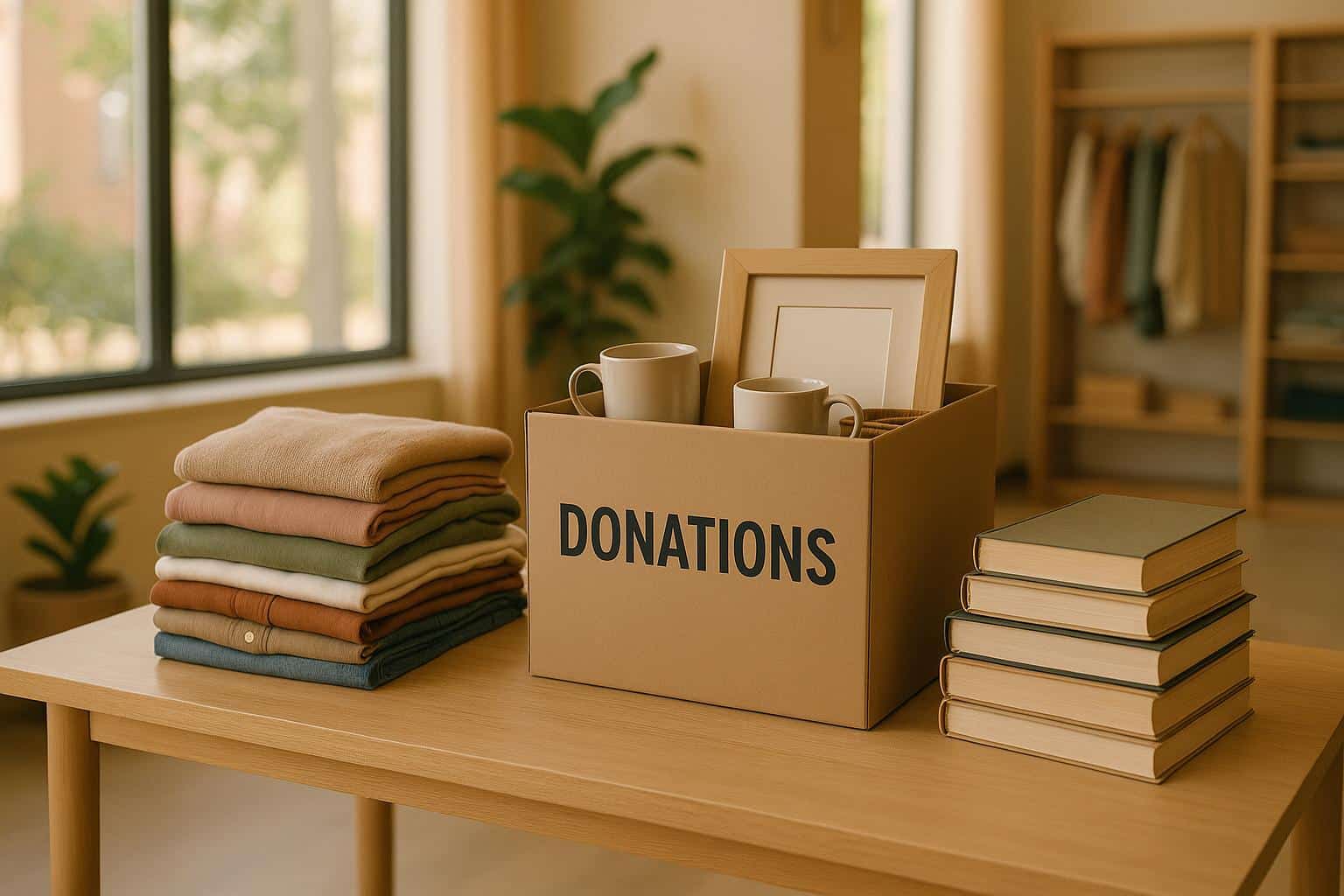
Donating to thrift stores like Red Racks helps veterans, reduces waste, and supports local communities. Here’s a quick guide to make your donation process smooth and impactful:
- Accepted Items: Clean, functional clothing, small furniture, electronics, books, and more.
- Not Accepted: Mattresses, large appliances, baby items, hazardous materials, or damaged goods.
- Preparation Tips: Wash clothing, test electronics, and pack items securely.
- Benefits: Supports veterans’ programs, reduces landfill waste, and creates jobs.
Pro Tip: Always check your local store’s guidelines and ask for a receipt for potential tax deductions.
Your donations make a real difference – start today!
Accepted Donation Items
Item Quality Standards
To ensure donations are useful and appreciated, items must be clean, functional, and in good condition – essentially, things you’d feel confident giving to a friend. Here’s what’s expected:
- Items should be free from stains, tears, or damage.
- Electronics and appliances must work properly.
- Clothing should be freshly washed or dry-cleaned.
- Games and toys must include all parts.
- Items must comply with safety standards and should not be on recall lists.
Below is a guide to the types of items we accept when they meet these standards.
List of Accepted Items
Here’s what we’re happy to receive, provided they meet the quality guidelines:
Clothing and Accessories
- Clothing for men, women, and children
- Shoes in wearable condition
- Accessories like belts, scarves, and jewelry
- Household linens, including towels, bed sheets, and curtains
Home Goods
- Kitchenware such as pots, pans, utensils, and dishes
- Small, functional appliances
- Home decor items
- Light fixtures and ceiling fans
- Window coverings
Furniture and Equipment
- Compact sofas and loveseats
- Dining tables, coffee tables, and other small furniture
- Bookcases and storage units
- Exercise equipment (must be less than 10 years old)
- BBQ grills (propane tanks must be removed)
Electronics
- Flat-screen TVs (no older than 2 years)
- Working audio equipment
- DVD players and stereos
- Small electrical appliances
Special Interest Items
- Books and magazines
- Sports and camping gear
- Musical instruments
- Collectibles and antiques
- Clean medical aids like crutches, walkers, and shower chairs
For unique or less common items, it’s a good idea to call your local store ahead of time. This ensures your donation meets current guidelines and can be accepted without issues.
Items Not Accepted for Donation
Declined Items Overview
To ensure safety and manage operations effectively, certain items cannot be accepted:
Furniture and Large Items
- Mattresses and box springs
- Oversized furniture (weighing over 50 lbs)
- Large appliances like washers, dryers, refrigerators, and dishwashers
- Entertainment centers and TV cabinets
- Home gyms and heavy exercise equipment
Safety-Regulated Items
- Baby items, including cribs, car seats, walkers, and high chairs
- Recalled products (check the Consumer Product Safety Commission website at www.cpsc.gov)
- Tube TVs and non-flat screen televisions
- Firearms, weapons, and fireworks
- Hazardous materials
Health and Sanitation Items
- Used cosmetics and personal care products
- Opened health and beauty items
- Food and beverages
- Moldy or strong-smelling items
- Medical supplies
Building and Automotive Supplies
- Construction materials
- Auto parts, tires, and batteries
- Plumbing fixtures
- Building supplies
- Paint and chemicals
These guidelines are in place to protect shoppers and manage operational costs.
Why These Items Are Restricted
Red Racks Thrift Stores follows strict rules to ensure safety, legal compliance, and efficient operations while reducing unnecessary disposal costs.
| Restriction Type | Reason | Example |
|---|---|---|
| Safety Concerns | Protecting consumers | Faulty electronics |
| Health Standards | Meeting sanitation rules | Medical devices |
| Legal Compliance | Following regulations | Baby equipment |
| Practical Limitations | Storage and handling | Heavy machinery |
If your item falls into one of these categories, consider other donation options:
- Electronics recycling centers for old computers and TVs
- Habitat for Humanity for building materials
- Vehicle donation programs for auto parts
- Medical equipment donation centers for specialized items
- Food banks for unopened food products
For the most up-to-date guidelines, reach out to your local store.
Donation Preparation Steps
Getting your donations ready the right way can make processing faster and increase their impact.
Clean and Sort Your Items
Before donating, inspect everything carefully. Make sure electronics and appliances work as they should, and wash all clothing. Toss out anything broken or missing parts.
Organize your donations into these categories:
- Clothing and accessories
- Small household items
- Electronics and appliances
- Books and media
- Toys and games
Once sorted, pack items securely so they stay in good shape during transport.
Pack and Label Items
Use proper packing methods to keep everything safe.
| Item Type | Packing Method |
|---|---|
| Clothing | Use clean bags or boxes, sorted by size |
| Small Items | Pack in sturdy boxes; wrap fragile items |
| Electronics | Use original boxes if possible, and include components |
| Sets/Collections | Keep all pieces together in one container |
Organized packing helps donation centers process your items more efficiently.
Tax Deduction Records
If you’re donating for a tax deduction, keep good records. Always ask for a donation receipt, as eligible donations can be tax-deductible. Check the donation center’s hours and follow their drop-off guidelines to make the process smoother.
Community Benefits of Donations
When you donate, you’re not just giving away items – you’re creating positive ripple effects across your community.
Support for Veterans Programs
Donations directly fund essential services for veterans, such as medical care, job training, and housing assistance, through organizations like Disabled American Veterans (DAV).
Local Employment Impact
Thrift stores rely on your contributions to create stable jobs and offer growth opportunities. Plus, unsold items sold to outside vendors help drive local employment further and make affordable clothing accessible.
Waste Reduction Results
| Impact Area | Key Statistics |
|---|---|
| Fashion Industry’s Carbon Emissions | Accounts for 10% of global emissions |
| Average Textile Waste per American (Yearly) | 70 pounds |
| Textile Industry’s Water Pollution Rank | Second-highest globally |
Conclusion: Your Donations Make a Difference
Your donations fuel meaningful change in our communities. Red Racks turns these contributions into support for veterans and local assistance programs. The results speak for themselves: over 700,000 veteran transportation services for medical appointments and more than 300,000 benefit claims processed each year.
By donating, you also help reduce waste. Textiles are reused or responsibly recycled, keeping valuable items out of landfills. Beyond that, your donations create jobs locally and provide essential funding for veteran services like medical care, job training, and housing support.
Every donation – big or small – brings us closer to stronger, more connected communities. Your generosity supports veterans and promotes responsible practices, making a real impact today and for the future.
FAQs
How can I make sure my donation to Red Racks Thrift Stores qualifies for a tax deduction?
To ensure your donation to Red Racks Thrift Stores qualifies for a tax deduction, always request a receipt from the cashier or donation attendant when you drop off your items. The receipt serves as proof of your contribution for tax purposes.
If your donation is valued at $250 or more, you’ll also need a written acknowledgment from the organization. This document should include details such as the donation date, a description of the items, and a statement confirming that no goods or services were received in exchange for the donation.
For accurate record-keeping, it’s a good idea to make a detailed list of the items you’re donating, along with their estimated fair market value. Consult a tax professional if you have questions about claiming deductions on your tax return.
How can I donate a unique or uncommon item to Red Racks Thrift Stores?
If you have a unique or uncommon item you’d like to donate, we recommend contacting your local Red Racks Thrift Store directly. This helps ensure the item is something they can accept and resell to benefit community programs. Examples of unique items might include collectibles, antiques, or specialty furniture.
Before donating, make sure the item is in good condition and clean. If you’re unsure about whether your item can be accepted, a quick call to the store can provide clarity and save you time. Thank you for considering Red Racks Thrift Stores for your donation!
Why doesn’t Red Racks Thrift Stores accept items like baby gear or large appliances?
Red Racks Thrift Stores cannot accept certain items, such as baby equipment and large appliances, due to state health and safety regulations or concerns about product condition. Items like cribs, car seats, and strollers often have strict safety standards, while large appliances may pose logistical challenges or safety risks.
Additionally, some items may be declined because they are difficult to resell or require costly disposal if they cannot be sold. To ensure your donations make the biggest impact, consider donating clean items, in good working condition, and fall within the store’s accepted categories.





